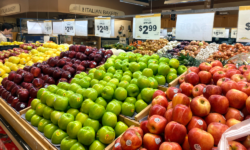While people have been paying more for many goods and services such as food and rent during the last several years, there’s at least one consumer item bucking that trend: legal cannabis.
According to a Capital Current analysis of data from Statistic Canada’s Consumer Price Index, the cost of recreational cannabis was down 3.6 per cent nationwide in December 2023, compared to the same time last year. “Recreational cannabis” refers to the dried cannabis flower, the agency says.
The yearly decrease continues a trend dating back to 2018 when the federal government legalized weed. Since legalization, the cost has decreased 28 per cent.
“There [are] just not enough consumers buying legal cannabis for all those stores to make a good profit,” said Michael Armstrong, a cannabis policy researcher and an associate economics professor at Brock University. His focus is on policy and the economic state of the Canadian cannabis industry. Armstrong says that one cause of this downward trend is competition. He also says that there are too many stores.
The problem worsened because of the overproduction of cannabis in Ontario. “There’s way more cannabis being grown than ultimately was sold.”

There are more than 3,600 authorized cannabis stores in Canada with 1,939 in Ontario according to the Alcohol and Gaming Commission of Ontario. This number does not account for unauthorized stores or the illegal market.
The 2023 Canadian Cannabis Survey data showed that more than 54 per cent of Canadians could not tell a legal package of cannabis. Even with the authorized stores largely available to the public, people are still unaware of which ones are legitimate.
“Our legal industry also is competing with the illegal industry and that is because of competition, pushing prices down,” said Armstrong.
While the number of stores has increased, only one in six adults use cannabis regularly according to data from Health Canada, with one in four having consumed it in the past 12 months.
According to Armstrong, a driving factor for cannabis’ price decrease, particularly in Ontario, is the concentration of stores. In urban areas of Ontario, it is not uncommon for there to be multiple cannabis stores within mere blocks of each other.
“When I started working here there were five stores within three blocks,” said Zoe Amo, an employee at One Plant Glebe, a cannabis dispensary. “Now there are only three because the others went out of business”.
“We’re in a position where we can do well because we’re a corporation but I could see how that would be hard for a small business wanting to get into [cannabis],” they said.
With the rollout of cannabis dispensary licenses, the backlog of applications using the lottery system made it possible for multiple stores to be located in the same location and open at a similar time.
“That's not normally something you see in other sectors, because in other sectors, you already have an established market,” said Armstrong.
“If you're going to open a hamburger place, you're gonna look on the map, say, where's a good spot for hamburger place, but you're also gonna look at a map, say, where are there already hamburger places?” said Armstrong. “[With] cannabis, it was a blank map. And you didn't know where the other entrepreneurs are going to go until it’s too late.”
Armstrong does not see the price of weed dropping much more.
Amo says, in his experience, more people now seem willing to experiment beyond what they are normally consuming. For example, a lot more people are trying edibles or flower because it is cheaper.
For regular cannabis consumers, the price decreases have saved them money.
“People tend to buy weed in bulk because it's cheaper,” said Ravyn Boden-Miller, a Carleton University student. “I currently have a lot of weed right now sort of stashed for the future, but if it was more expensive, I wouldn't be able to do that.”




